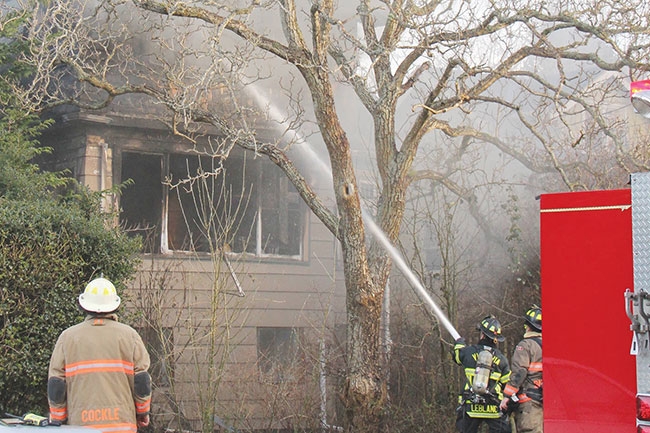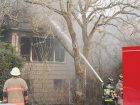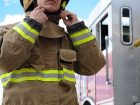
Features
Health and wellness
Hot topics
A continuum of firefighter care
We were recently tasked within our fire department to put our health and wellness program to the test. Our department was involved in what firefighters refer to as a ‘once in a career’ traumatic event that profoundly impacted our first responders, families, and our community.
March 5, 2018
By Dave Cockle and Sara Wegwitz
 Oak Bay’s health and wellness program is designed to encourage all members take actions to identify and reduce the impacts of health risks and behaviours before incidents (like the structure fire pictured) occur. We were recently tasked within our fire department to put our health and wellness program to the test.
Oak Bay’s health and wellness program is designed to encourage all members take actions to identify and reduce the impacts of health risks and behaviours before incidents (like the structure fire pictured) occur. We were recently tasked within our fire department to put our health and wellness program to the test.The event involved the tragic loss of life for two young children through a homicide. Our fire department worked alongside other first responders such as police and paramedics to provide medical first response at the incident. The elements of a health and wellness program fit perfectly into the emergency management principles in support of our greatest asset – our firefighters. The following article takes a closer look at how these principles apply to the continuum of care that fosters the health and wellbeing of firefighters and will outline the steps we took in response to this tragic incident.
As fire service leaders, we plan emergency management through the principles of prevention, mitigation, preparedness, response, and recovery. We use these principles to create plans and education to enhance public safety for our community and first responders. The recent events within the community provided an opportunity to reflect on these principles and correlate them to our health and wellness program and other resources we utilize to support our firefighters. The primary focus of our health and wellness program is to take a proactive and preventative approach. This enables the department to respond to incidents in a flexible and adaptable manner and in turn allows our responders to not only survive but to be resilient as they recover from the incident. When these critical incidents occur, it is important that fire departments have a full spectrum of resources to draw from to support their firefighters. Like in sports, it is imperative to have an offensive and defensive game plan and strategies; and in this case both proactive and reactive strategies and responses.
■ Prevention and mitigation
The foundation of our health and wellness program begins with a holistic upstream approach to the first pillar of emergency management: prevention and mitigation. Research has shown that the more you invest in prevention training and education, the more you can prevent and mitigate mental and physical health
injuries. The program is designed so that all members take actions to identify and reduce the impacts of health risks and behaviours before incidents and mental and physical injuries occur. We work collaboratively with our team and a registered nurse to identify common health risks for firefighters, and provide the education and tools required to reduce those risks. We empower our people through firefighter specific training and education sessions that promote ongoing participation in improving physical fitness, proper nutrition, sleep hygiene, and mental fitness strategies. We are consistently proactive in researching health and wellness trends for first responders while keeping a ‘pulse check’ on members’ current state of health. Our program is flexible and adaptable to meet the needs of our members. We adjust and implement changes to our health and wellness programming throughout the year to reflect both areas.
■ Preparedness
At this step we ensure our members have the capabilities and skills to respond and recover from the stresses of an incident. The preparedness step is where the work begins to enrich the firefighters with the tools they need to not only survive, but to thrive throughout their career in the fire service.
We introduced policy and procedures to our daily schedule to provide for health and wellness training opportunities for our team. The policies and procedures included changing the daily routine that had been in place for many years. The daily routine was very military regimented as to what we accomplish for every hour of the shift. Through our research, and guidance from our registered nurse, we discovered that by changing the physical fitness and drill periods during the shift to better align with proper nutrition and rest periods we could still achieve our goals while being more effective and efficient. We aligned occupational health and safety, peer counselling, and critical incident stress management teams as part of our health and wellness continuum. This created opportunities for different budget funding sources for training of staff as well as working within WorkSafeBC regulations. We created and continue to support sessions presented by mental health professionals that provide members with tools to help to recognize symptoms of stress, gain coping strategies, and learn how to access assistance. These sessions are planned on a quarterly basis and focus not only on demands of the fire service, but on stress management strategies for relationships and family when we go home. The department has recently participated in the Canadian Mental Health Association’s ‘Resilient Minds’ course for firefighters.
In addition, our health and wellness team firmly believe that the first time you need a medical professional should not be when you need them in an emergency state. Through our registered nurse Sara Wegwitz, we have afforded our members the opportunity to learn from various local health professionals who have provided inspiring training and education in the areas of holistic nutrition; functional fitness; sleep hygiene; stress management; and mental wellbeing. Our registered nurse provides these training sessions with guest presenters to open the door to the health world and give access to resources that support member preparedness. For example, we have had registered holistic nutritionists visit the department to provide education on nutrition while giving hands on experience by way of helping each crew cook a healthy meal on shift. We have had a local chiropractor visit each crew to talk about the stress response, how different stressors affect the body, and provided members with additional tools to better handle stress. We have access to a psychiatrist that supports our Critical Incident Stress Management Team. Our registered nurse also plays a role in assisting our members to navigate the medical system as needed to ensure our members receive the care and treatments that they require. The preparedness step ensures firefighters have the training, education, and capacity to respond or reach out for additional resources and support. The program, because of its holistic upstream approach, supports the response and recovery of our members by ensuring that they maintain a level of job preparedness.
Response
When we consider the response principles of emergency management, we are drawn to the actions taken during an event to reduce loss and impact. If we apply this principle to the firefighters through the health and wellness program, we can draw on the steps we have taken in the prevention/mitigation and preparedness stages to reduce the impact on our responders. We provide our firefighters with the tools to identify the signs and symptoms of mental injury and assist with managing these through the support channels that we have created. The following are some of the steps that we took in response to this incident.
We acted quickly to remove our affected members from the stress of the incident by backfilling for a few hours while we deployed our Critical Incident Stress Management trained resource team to support these first responders. We contacted every member in the department to let them know that members of the team had been to a significant incident (no need for them to hear it in the news). Our mental health team was contacted, and two sessions were scheduled for the responding members to allow for debriefing with a professional. A system of monitoring was put in place for all members to assist in the identifying of needs for healing and intervention. With a caring and watchful eye, we continue to monitor and deliver support for those affected.
It was requested that the department assist with the organization of a community candlelight vigil to provide some comfort to the family and residents of the community. We proudly stepped up to assist in providing this service to allow the time and space for our community to mourn and begin the healing process. Members attending the vigil were requested by the department not to be in uniform as this event was organized for community members and responders to come together to grieve and show support in a safe environment. This important consideration allowed the responders to participate as a member of the community without being besieged as a responder, providing the opportunity to be as one.
We had over two thousand people attend. Community comments included:
“Your team was strong, responsive, and compassionate – your actions and your words creating a safe space to come together to grieve”
“The night was raw and beautiful, we are immensely grateful for your caring and thoughtful leadership of a very tender and important evening.”
The proactive steps of prevention/mitigation and preparedness provided the necessary skills and support for our members to respond and continue recovery from this event. This incident reaffirmed the importance of training our firefighters in every aspect of our job and how the wellbeing of a first responder needs to be viewed as a continuum of care. Fire departments and first responders must be able to react and adapt and have firefighter resources in place at all ends of the continuum of care.
Recovery
As we reflect on the incident we had in our community, the response of our firefighters, and the subsequent recovery process that we continue to work through, we are encouraged by the steps we have taken through the health and wellness program to support members. While all pillars are necessary as part of a continuum of care, the more a department invests resources in the prevention and mitigation and preparedness stages, the more firefighters can better bounce back and adapt to critical incidents.
The quip “time heals all” is well past its prime in the fire service. Today’s firefighters require a full complement of resources along a continuum that foster their overall health and well-being so that they not only survive but thrive throughout their career.
Chief Dave Cockle has been a career firefighter with the Oak Bay Fire Department for 30 years. Contact him at dcockle@oakbay.ca
Sara Wegwitz is a registered nurse who specializes in mental fitness and resilience training. She is the primary facilitator of the Oak Bay Fire Department’s wellness program. Contact her at sara@tailormakinghealth.ca
Print this page
Advertisement
- Volunteer Vision: Reflecting back and looking forward
- Mississauga hires Kalpana Rajgopalan as assistant chief

